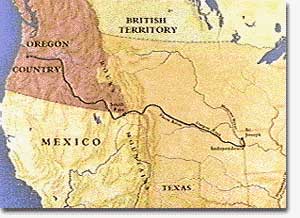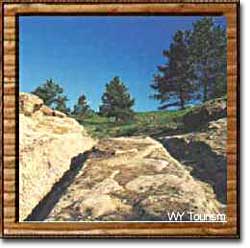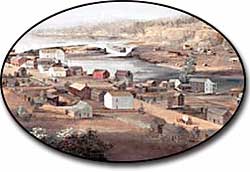Does the Stony Hill School Represent the British Colonies

29b. 54° 40' or Fight

The West
Map showing the Oregon Trail, Oregon Country, and northern Mexico
The southern boundary of the United States with Mexico was not the only western territory under dispute. The Oregon Territory spanned the modern states of Oregon, Idaho, and Washington, as well as the western coast of Canada up to the border of Russian Alaska. Both Great Britain and America claimed the territory. The Treaty of 1818 called for joint occupation of Oregon — a solution that was only temporary. Led by missionaries, American settlers began to outnumber British settlers by the late 1830s. But Britain was not Mexico. Its powerful navy was still the largest in the world. Twice before had Americans taken up arms against their former colonizers at great expense to each side. Prudence would suggest a negotiated settlement, but the spirit of manifest destiny dominated American thought. Yet another great showdown loomed.

Wagon tracks leftover from the Oregon Trail pioneers still crisscross the American midwest.
Oregon fever swept the nation in the 1840s. Thousands of settlers, lured by the lush Willamette Valley headed west on the Oregon Trail. Families in caravans of 20 or 30 braved the elements to reach the distant land. Poor eastern families could not generally make the trip, as outfitting such an expedition was quite expensive. The Conestoga wagon, oxen and supplies comprised most of the cost. The families fought Native Americans at times, but often they received guidance from the western tribes. It took six months of travel at the speed of fifteen miles per day to reach their destination.
In the east, the subject of Oregon was less personal and more political. In 1844 the Democrats nominated James K. Polk, an unknown candidate from Tennessee. It appeared as though the Whig Party candidate, Henry Clay, would win in a landslide. Very few Americans had ever heard the name Polk, but Clay's illustrious career was widely known. However, Polk was an excellent strategist. He tapped into the public mood and realized that manifest destiny was the very issue that could lead him to victory. Polk called for expansion that included Texas, California, and the entire Oregon territory. The northern boundary of Oregon was the latitude line of 54 degrees, 40 minutes. "Fifty-four forty or fight!" was the popular slogan that led Polk to victory against all odds.

John Mix Stanley
Oregon City, along the banks of the Willamette River, the final stop along the Oregon Trail as it appeared in 1848.
Claiming the territory in an election campaign was one thing. Acquiring it from the powerful British was another. Although Polk blustered about obtaining the entire territory from Britain, he was secretly willing to compromise. Trouble was brewing with Mexico in the south. Surely the new nation could ill afford to fight Mexico in the southwest and the British in the northwest simultaneously. Nevertheless, Polk boldly declared to Great Britain that joint occupation would end within one year. The British were confident they could win, but by 1846 they were vastly outnumbered in Oregon by a margin of greater than six to one. In June of that year, Britain proposed splitting Oregon at the 49th parallel. Polk agreed to the compromise, and conflict was avoided.
![]()
All about the Oregon Trail
The producers of the documentary film "The Oregon Trail" which was aired on PBS have put together this informative site on the Oregon Trail. There are a good number of short articles on the Trail, those who took it and the hardships they encountered.
Report broken link
Convention of 1818 Between the United States and Great Britain
Here is the full text of the treaty which divided the United States and Canada along the 49th Parallel "from the Lake of the Woods to the Stony Mountains" (the Rocky Mountains). Article III allowed the territory west of the Rockies (the Oregon territory) to be "free and open...to the Vessels, Citizens, and Subjects of the Two Powers."
Report broken link
End of the Oregon Trail Home Page
The End of the Oregon Trail Interpretive Center located at Oregon City, Oregon, offers many of its numerous and valuable documents online, as well as many articles on the first pioneers and explorers, the overlanders, and the settlement of the Willamette Valley. Informative, easy-to-read, and loaded with pictures. Don't miss this site.
Report broken link
The Applegate Trail
The treacherous Columbia River along the Oregon Trail took the lives of two 9-year-old cousins. Their fathers, Lindsay and Jesse Applegate vowed to find a safer route to the Willamette Valley. Three years later the first wagon train left for Oregon along the Applegate Trail.
Report broken link
If you like our content, please share it on social media!

![]()
Does the Stony Hill School Represent the British Colonies
Source: https://www.ushistory.org/us/29b.asp
0 Response to "Does the Stony Hill School Represent the British Colonies"
Post a Comment